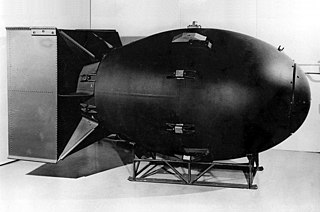
"Fat Man" was the codename for the type of nuclear weapon the United States detonated over the Japanese city of Nagasaki on 9 August 1945. It was the second of the only two nuclear weapons ever used in warfare, the first being Little Boy, and its detonation marked the third nuclear explosion in history. The first one was built by scientists and engineers at Los Alamos Laboratory using plutonium manufactured at the Hanford Site and was dropped from the Boeing B-29 Superfortress Bockscar piloted by Major Charles Sweeney.
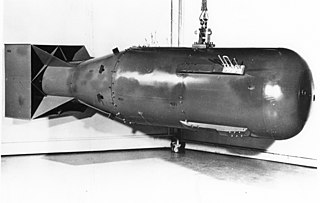
Little Boy is the name of the type of atomic bomb used in the bombing of the Japanese city of Hiroshima on 6 August 1945 during World War II, making it the first nuclear weapon used in warfare. The bomb was dropped from the Boeing B-29 Superfortress Enola Gay piloted by Colonel Paul W. Tibbets Jr., commander of the 509th Composite Group, and Captain Robert A. Lewis. It exploded with an energy of approximately 15 kilotons of TNT (63 TJ) and had an explosion radius of approximately 1.3 kilometers which caused widespread death across the city. The Hiroshima bombing was the second nuclear explosion in history, after the Trinity nuclear test.

The Manhattan Project was a research and development program undertaken during World War II to produce the first nuclear weapons. It was led by the United States in collaboration with the United Kingdom and Canada. From 1942 to 1946, the project was directed by Major General Leslie Groves of the U.S. Army Corps of Engineers. Nuclear physicist J. Robert Oppenheimer was the director of the Los Alamos Laboratory that designed the bombs. The Army program was designated the Manhattan District, as its first headquarters were in Manhattan; the name gradually superseded the official codename, Development of Substitute Materials, for the entire project. The project absorbed its earlier British counterpart, Tube Alloys, and subsumed the program from the American civilian Office of Scientific Research and Development. The Manhattan Project employed nearly 130,000 people at its peak and cost nearly US$2 billion, over 80 percent of which was for building and operating the plants that produced the fissile material. Research and production took place at more than 30 sites across the US, the UK, and Canada.
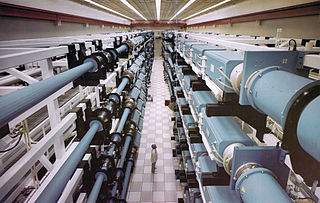
Inertial confinement fusion (ICF) is a fusion energy process that initiates nuclear fusion reactions by compressing and heating targets filled with fuel. The targets are small pellets, typically containing deuterium (2H) and tritium (3H).

The Georgia Dome was a domed stadium in the Southeastern United States. Located in Atlanta between downtown to the east and Vine City to the west, it was owned and operated by the State of Georgia as part of the Georgia World Congress Center Authority. Opened in 1992, it was then the second-largest covered stadium in the world by capacity, behind the Pontiac Silverdome. Though the Georgia Dome was a profitable facility, its primary tenant, the Atlanta Falcons of the National Football League, grew dissatisfied with it less than two decades after its opening and began planning for a replacement stadium. It was closed and demolished in 2017.
The Royal Canberra Hospital implosion was a failed building implosion that killed one person and injured nine others. The implosion occurred on 13 July 1997, when the city's superseded hospital buildings at Acton Peninsula on Lake Burley Griffin were demolished to make way for the National Museum of Australia.

Trojan Nuclear Power Plant was a pressurized water reactor nuclear power plant in the northwest United States, located southeast of Rainier, Oregon, and so far, the only commercial nuclear power plant to be built in Oregon. There was much public opposition to the plant from the design stage. The three main opposition groups were the Trojan Decommissioning Alliance, Forelaws on the Board, and Mothers for Peace. There were largely non-violent protests from 1977, and subsequent arrests of participants.
Energy Northwest is a public power joint operating agency in the northwest United States, formed in 1957 by Washington state law to produce at-cost power for Northwest utilities. Headquartered in the Tri-Cities at Richland, Washington, the WPPSS became commonly known as "Whoops!", due to over-commitment to nuclear power in the 1970s which brought about financial collapse and the second largest municipal bond default in U.S. history. WPPSS was renamed Energy Northwest in November 1998, and agency membership includes 28 public power utilities, including 23 of the state's 29 public utility districts.

The Green Team is a fictional comic book team of rich-kid adventurers published by DC Comics. The team debuted in 1st Issue Special #2, and was created by Joe Simon and Jerry Grandenetti. In its initial appearance, the group was subtitled "Boy Millionaires". In 2010s comics, a revamped version of the group appeared in a series subtitled "Teen Trillionaires", thus adjusting for both inflation and the declining popularity of boy adventurers.
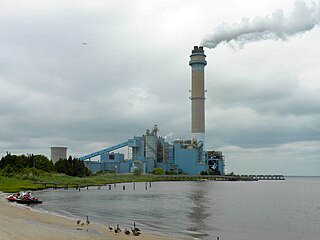
The B.L. England Generating Station, also called Beesley's Point Generating Station, was a power plant in Upper Township, Cape May County, New Jersey, United States, on the Great Egg Harbor River. The facility provided approximately 450 megawatts of generating capacity from three generating units. Two units burned coal (and up to 7 percent Tire-derived fuel) and the third unit burned bunker C oil. Its large smokestack, altered to resemble a lighthouse, contained a sulfur dioxide scrubber which removed the SO2 from the flue gas and converted it into gypsum, which can be sold. The scrubber allowed the two coal units to use less expensive high sulfur coal from West Virginia.

Nuclear Implosions: The Rise and Fall of the Washington Public Power Supply System is a 2008 book by Daniel Pope, a history professor at the University of Oregon, which traces the history of the Washington Public Power Supply System, a public agency which undertook to build five large nuclear power plants, one of the most ambitious U.S. construction projects in the 1970s.

Muskingum River Power Plant was a 1.5-gigawatt coal power plant, owned and operated by American Electric Power (AEP). It was located on the west bank of Muskingum River, about 4 miles (6 km) northwest of the town of Beverly, Ohio in Washington County, Ohio. At its peak, the plant powered three million households. The plant operated from 1953 until ceasing generation in 2015.
The R. Gallagher Generating Station was a four-unit coal-burning power plant located along the Ohio River some two miles (3 km) downstream from New Albany, Indiana in southernmost Floyd County, Indiana. The total aggregate capacity (year-around) of the plant's four identical units was 560MW. Unit 2 began operating in 1958; unit 1 in 1959; unit 3 in 1960 and unit 4 in 1961. In early 2012, both Units 1 and 3 were retired. Units 2 and 4 continued to operate because Duke Energy installed baghouses, greatly reducing the pollution and meeting the current standards set by the EPA. The plant's 2012 output was 280 megawatts. The plant is connected to the grid by 138 and 230 kilovolt transmission lines.

Washington Nuclear Project Nos. 3 and 5, abbreviated as WNP-3 and WNP-5 were two of the five nuclear power plants on which construction was started by the Washington Public Power Supply System in order to meet projected electricity demand in the Pacific Northwest. WNP-1, WNP-2 and WNP-3 were part of the original 1968 plan, with WNP-4 and WNP-5 added in the early 1970s.
Matla Power Station in Mpumalanga, South Africa, is a coal-fired power plant operated by Eskom and consuming the output from the Matla coal mine.
Wabamun Generating Station was a coal-fired power station owned by TransAlta, located next to the village of Wabamun, Alberta. The station's primary source of fuel was sub bituminous from the Whitewood mine. Unit 3 was retired in 2002; Units 1 and 2 on December 31, 2004, and Unit 4 on March 31, 2010. On August 11, 2011, the main building was levelled by a controlled implosion. Plans for the site include high rise condos and a waterfront.
The 1970 Colombia earthquake occurred in Colombia on July 31.

The Marysville Power Plant, nicknamed the Mighty Marysville, was a coal-fired power plant in Marysville, Michigan on the shore of the St. Clair River. The plant was demolished on November 7, 2015, after the land was sold to a developer.
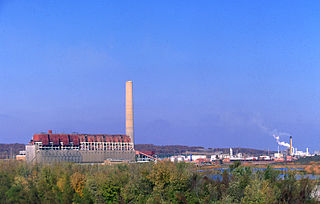
The Johnsonville Fossil Plant was a 1.5-gigawatt, coal power plant located in New Johnsonville, Humphreys County, Tennessee, United States. The plant generated electricity from 1951 to 2017. It was operated by the Tennessee Valley Authority (TVA).













